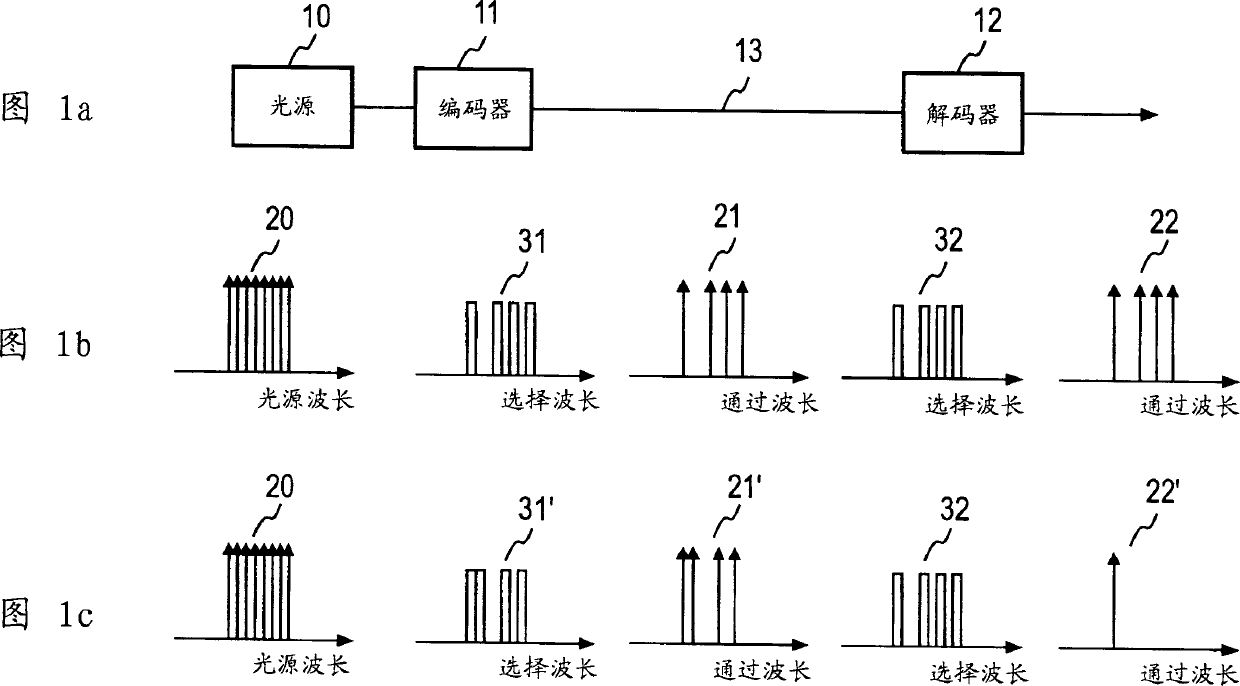Optical communication system using optical frequency code, optical transmission device and optical reception device thereof, and reflection type optical communication device
An optical communication system and optical coding technology, applied in the field of optical communication systems, can solve problems such as deterioration of communication quality and poor extinction ratio of downlink optical signals, and achieve the effect of rough control accuracy and easy realization
- Summary
- Abstract
- Description
- Claims
- Application Information
AI Technical Summary
Problems solved by technology
Method used
Image
Examples
no. 1 approach
[0112] First Embodiment (Optical Code Multiplexing)
[0113] The first embodiment of the present invention can perform optical code multiplexing, but it can also not be optical multiplexing, that is, it is applied to the optical communication of a data sequence. In order to make the title of this item easy to distinguish from the implementation mode, add brackets and write as (optical code multiplexing).
[0114] First, examples of transmitting and receiving side devices to which the present invention can be applied will be described. FIG. 2(a) shows an example of an optical transmission end device to which the first embodiment is applied. n=1, 2, ..., N (N is an integer greater than or equal to 2), the light source 10 n and encoder 11 n group of 14 via fiber n Connect to multiplexer 15. Each encoder 11 n Input data sequence D in n , data sequence D n by Encoder 11 n Encoded as an optically encoded signal through optical fiber 14 n It is input to the multiplexer 15 a...
Embodiment 1-1
[0118] FIG. 4 shows a communication system of a system to which Example 1-1 of the first embodiment can be applied. This embodiment 1-1 is the same as the existing optical communication system, has a light source 10, an encoder 11, a decoder 12, an optical transmission path (optical fiber) 13, and furthermore, includes a dispersion compensator 17 in this embodiment 1-1, Since the frequency-dependent propagation delay time differs due to the frequency dispersion of the optical transmission path, average compensation is performed so that the delay time between transmission and reception of each frequency component constituting the optical coded signal is the same. The optical frequency region to be compensated by the dispersion compensator 17 is at least wider than the optical frequency region used as the optical code signal.
[0119] The light source 10 outputs at least an optical signal of an optical bandwidth FSR corresponding to a code length FCL (common multiple of FSRi des...
Embodiment 1-2
[0139] Example 1-2 of the first embodiment is a concrete example of Example 1-1, and is an example using a trigonometric function as the coding function C(f). In the present embodiment 1-2, use the value of a as small as possible (positive integer), and under the situation that r ' codes are generated with the same value of a, a takes from 1 to the maximum number of codes (maximum coverage encoder Number) N divided by the integer value of the value N / r' of r', when r is set to 0, 1, ..., r'-1 of the remainder of r', as the nth light The coded signal Cn(f) is represented by the following formula.
[0140] Cn(f)=(1+cos(2·π·a·f / FCL+r·π / 2)) / 2 (7)
[0141] The optically encoded signal function value Cn(f) is a value from 0 to 1, and the encoder 11 n The integral value in the interval of any code length FCL in the encoding object is FCL / 2, and the encoder 11 n In the optical frequency region to be coded, the light transmission characteristic repeats the function value Cn(f) withi...
PUM
 Login to View More
Login to View More Abstract
Description
Claims
Application Information
 Login to View More
Login to View More - R&D
- Intellectual Property
- Life Sciences
- Materials
- Tech Scout
- Unparalleled Data Quality
- Higher Quality Content
- 60% Fewer Hallucinations
Browse by: Latest US Patents, China's latest patents, Technical Efficacy Thesaurus, Application Domain, Technology Topic, Popular Technical Reports.
© 2025 PatSnap. All rights reserved.Legal|Privacy policy|Modern Slavery Act Transparency Statement|Sitemap|About US| Contact US: help@patsnap.com



